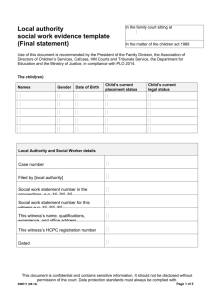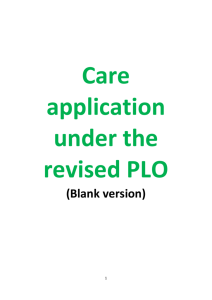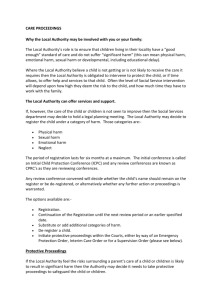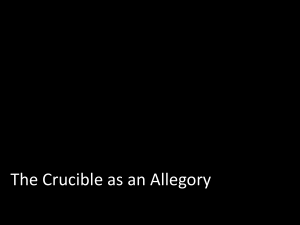Local authority social work evidence template
advertisement
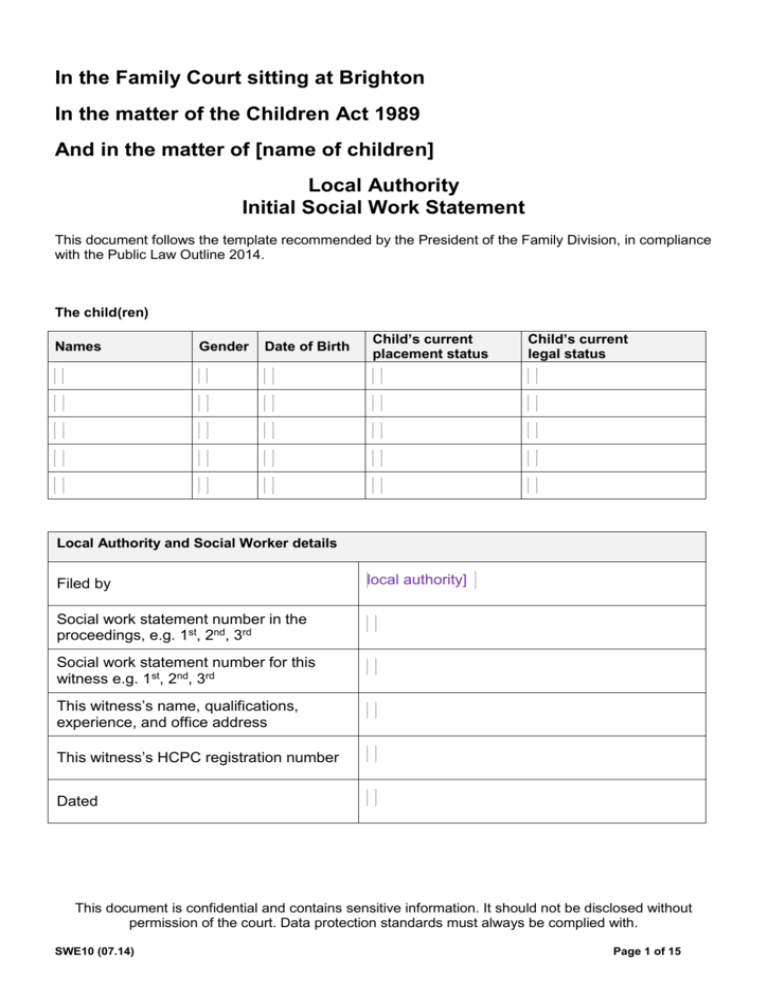
In the Family Court sitting at Brighton In the matter of the Children Act 1989 And in the matter of [name of children] Local Authority Initial Social Work Statement This document follows the template recommended by the President of the Family Division, in compliance with the Public Law Outline 2014. The child(ren) Names Gender Date of Birth Child’s current placement status Child’s current legal status Local Authority and Social Worker details Filed by local authority] Social work statement number in the proceedings, e.g. 1st, 2nd, 3rd Social work statement number for this witness e.g. 1st, 2nd, 3rd This witness’s name, qualifications, experience, and office address This witness’s HCPC registration number Dated This document is confidential and contains sensitive information. It should not be disclosed without permission of the court. Data protection standards must always be complied with. SWE10 (07.14) Page 1 of 15 Contents page Page no. Section 1 Case details 1.1 Family composition 1.2 Genogram 1.3 Ecomap 1.4 Summary of reason/s for order sought Section 2 The social work chronology Section 3 Analysis of harm 3.1 The social work analysis of harm and risk 3.2 The outcome and analysis of local authority involvement Section 4 Child impact analysis on each individual child 4.1 Analysis of the child’s daily life and experience 4.2 Any continuing risks the child faces 4.3 Analysis of the child’s welfare and development needs 4.4 The child’s wishes and feelings 4.5 The child’s own statement (where applicable) 4.6 Benefits and detriments to the child of any proposal/s for assessment, expert evidence adjournment or other delay Section 5 Analysis of parenting capability Section 6 Analysis of wider family capability Section 7 The proposed care plan for each child 7.1 Table of realistic placement options 7.2 The preferred and proposed placement option, with the reasons 7.3 The contact plan Section 8 Views and issues raised by other parties (where known) 8.1 Mother’s views 8.2 Father’s views 8.3 Views of wider family members 8.4 Views of any other parties or significant others Section 9 Updating where there are minor changes 9.1 Update on matters set out in the application 9.2 Any proposals for further evidence assessment that the court should consider Section 10 Statement of procedural fairness Section 11 Signature This document is confidential and contains sensitive information. It should not be disclosed without permission of the court. Data protection standards must always be complied with. SWE10 (07.14) Page 2 of 15 1. Case details 1.1 Family Composition This section should include family members and relationships, especially the primary carers and significant adults/other children and should specify the relationship in respect of each child subject to the application. Please set out the family members' full names, their dates of birth, their nationality, ethnicity and their current addresses. Name Relationship Parental Responsibility DOB Nationality Ethnicity Address j This document is confidential and contains sensitive information. It should not be disclosed without permission of the court. Data protection standards must always be complied with. SWE10 (07.14) Page 3 of 15 1.2 Genogram (mandatory)(but format may be adapted) Include family members and their relationship to each child Include all other relatives Key: Female Male 1.3 Ecomap (risky and protective contacts) [optional – delete if not needed ] This document is confidential and contains sensitive information. It should not be disclosed without permission of the court. Data protection standards must always be complied with. SWE10 (07.14) Page 4 of 15 1.4 Summary of reason/s for order sought [Within this section provide a brief explanationof the order you are seeking, and a few lines on why it is considered necessary with reference to the child’s needs and the family’s capacity to meet them. ] Provide a brief overview of the key elements of the care plan, and refer the court to the interim care plan filed herewith. This statement is the initial statement filed on behalf of the local authority in respect of an application for an interim care/supervision order in respect of [ name and ages of children], with an interim care plan for [their removal into care/ enhanced supervision etc] The family has been known to Children’s Services since [insert date]. This statement should be read in conjunction with assessments filed herewith on behalf of the local authority, together with the more detailed chronology, Having carefully considered the matters set out in this statement, and the other assessments and evidence before the court the local authority have concluded that the children are suffering from significant harm arising from [insert summary of reasons for issue, and an outline of the care plan.] ……… This document is confidential and contains sensitive information. It should not be disclosed without permission of the court. Data protection standards must always be complied with. SWE10 (07.14) Page 5 of 15 2. The social work chronology (key elements) The Court is referred to the full LA chronology filed. This provides a fuller account of the history in this case. For the purposes of this statement I provide below key incidents which are crucial to the understanding of the reasons for proceedings and experiences of the family. [The chronology lists those events or a sequence of events which are significant in terms of their impact on the child. The chronology should be confined to the last two years unless an event before that point in time has a current – and therefore lasting significance, for example, a teenager who exhibits high risk behaviour as a result of historical sexual abuse, or cumulative evidence of neglect which needs to be summarised. Key incidents already listed in the application form can be re-stated here. We want to avoid a long narrative section. Try to make this no more than one or two pages, and no more than about 10 things. What is wanted here is core incidents and developments that would need to be known if you had to describe the case in less than two minutes – so changes of placement, changes in the parents’ relationship, any incidents of abuse, any major changes in circumstances that the Judge really needs to be made aware of. An example of this is: “There were 8 further episodes of domestic abuse between May and September, see the LA Chronology for more detail”]. In the column headed “significance” explain briefly the significance of the event cited. Date Incident or sequence of incidents relevant to the child’s welfare Significance This document is confidential and contains sensitive information. It should not be disclosed without permission of the court. Data protection standards must always be complied with. SWE10 (07.14) Page 6 of 15 3. Analysis of harm 3.1 The social work analysis of the harm the child (or each child) has suffered and/or the/any risk of harm the child continues to face, including the analysis of the event/s that led to the application i.e. the threshold as described in the application form I have considered the harm which (the child) has suffered or is at risk of suffering as a result of the parenting they are receiving, pursuant to my obligation to consider the Welfare Checklist at S 1 (3) (e) of the Childen Act 1989. The proceedings were issued as a result of [main triggering incident, and categorise it – physical harm, neglect, a combination of physical and emotional harm etc] . The local authority consider that the threshold criteria in this case is met. The interim threshold document filed herewith on behalf of the local authority details the harm that [the child] has suffered or is at risk of suffering. In summary [ insert a few summarising sentences to give the Court the key elements of why threshold is met, without repeating the threshold document verbatim.] 3.2 List of previous assessments and interventions Prior to proceedings being issued the family were the subject of a number of assessments, and interventions which I summarise below. Any reports arising from the assessments are available to the parties as part of the disclosure within the proceedings. Organisation Description of assessment/intervention Date Outcome and effectiveness This document is confidential and contains sensitive information. It should not be disclosed without permission of the court. Data protection standards must always be complied with. SWE10 (07.14) Page 7 of 15 4. Child impact analysis Where there is more than one child ensure each child is dealt with separately where appropriate, but where a specific factor has the same effect on each child there is no need to repeat this, the children can in this instance be dealt with collectively. This section demonstrates an understanding of the impact on the individual child of what has been happening to them. It needs to differentiate between the needs of the individual child as well as referring to what the needs are of a child of that age in the general population. The impact of the same event may be different on different children within the same family, so this section analyses the differential impact, as well as the factors supporting a child’s resilience in the face of what has happened. [Within this section, consider where relevant the conclusions and analysis of any independent expert reports already received . Indicate whether you are in agreement or not, and give a brief account of why. You may quote relevant sections, but keep this succinct – the Court has the reports and doesn’t need you to repeat huge chunks – just the key remarks]. You may in this section also wish to refer to any relevant reports/referrals from other agencies, eg school, health. 4.1 Description of the child’s daily life and experience at the time harm was identified In considering (the child’s) experiences I am mindful of my duty to consider their age, sex, background and any relevant characteristics per S1( 3)(d) of the Children Act Welfare Checklist [eg Jane is a four year old white British catholic girl, one of six siblings born to parents with long standing drug addiction issues. [What is the day to day life like of this child? What have you observed, what has the child told you and what have others told you about the child’s experience. Triangulate information with other sources.] 4.2 Any continuing risk of significant harm including impairment of development to the child balanced against any factors which mitigate that risk and support for the care of the child [Cross-refer to ecomap if used. Refer to Section 3.1 above. Consider both options, eg what would happen if the child were moved or if the plan were not approved? Do not repeat large chunks of your analysis of the parenting capacity or threshold – refer to it, and set out the risks if the issues identified about the parenting of this child were not addressed. Later in the statement template there is a section on parenting capacity. At this stage simply refer to your analysis of parenting capacity or threshold and set out the risks to the child if the parenting issues are not addressed. This may be an opportunity to refer to accepted bodies of research about child development. Also make explicit what would happen if the proposed care plan is approved.]. 4.3 Analysis of the child’s needs, against the welfare checklist This document is confidential and contains sensitive information. It should not be disclosed without permission of the court. Data protection standards must always be complied with. SWE10 (07.14) Page 8 of 15 I have considered the child’s physical, emotional and educational needs per the requirements of the Welfare Checklist at Section 1 (3)(b) of the Children Act 1989 [This will be your drawing together of what this child needs both now and in the future – you can also indicate where services would be needed to meet those needs and how you intend to provide those. If you have written more than half a page per child, think carefully about whether you need to make cuts / edits] 4.4 The child’s wishes and feelings and how these have been identified I have considered the child’s ascertainable wishes and feelings per the requirements of the Welfare Checklist at Section 1 (3)(a) of the Children Act 1989. [Make explicit not only what the child’s views are but also how you set about obtaining those views. If you have concerns that these views may be distorted by the child’s circumstances or due to communication difficulties or other issues also make this apparent.] 4.5 The child’s own statement (where applicable) [If you have nothing to put here indicate why it was not appropriate or possible to do this.] 4.6 Proposal/s for further assessment and consideration of the child’s timetable , [Set out the benefits and detriments to the child of any proposal/s for further assessment and, expert evidence, adjournment or other delay This is your opportunity to refer to the child’s timetable, with reference to accepted bodies of research, and say why a decision on the interim care plan needs to be made now, and the adverse consequences of delay, and to set out if it is in issue why you consider no further assessment is needed.] This document is confidential and contains sensitive information. It should not be disclosed without permission of the court. Data protection standards must always be complied with. SWE10 (07.14) Page 9 of 15 5. Analysis of Parenting Capability 5.1 Analysis of each parent’s capability to meet each child’s needs, including analysis of any capability gap and whether/how this can be bridged in the timetable for the child. [The analysis of parenting capability and of wider family and friends capability (in section 6) should address the fundamental question in each case – ‘can this parent or carer provide this child with a good enough standard of care for the rest of their childhood?’ This is an opportunity to set out your conclusions within your own SW assessment and why you have reached them. This will involve reference to the SW assessment and any other assessment reports conducted prior to the commencement of proceedings as well as work done during the proceedings. You will be drawing together the assessments of the ability of these parents to meet the needs of these children. Consider the conclusions and analysis of any reports previously commissioned. You may quote relevant sections, but keep this succinct – the Court has the reports and doesn’t need you to repeat huge chunks – just the key remarks. You need to consider prognosis for change - the response to any treatment services or goals the parents have been set to date. Remember that this assessment should be holistic and so will include consideration of the extent to which there has been any improvement since the original analysis of risk at the commencement of the involvement of children’s services with the family. You need to make a clear statement which lays out your judgment of risk based on a clear account of vulnerabilities, strengths and probability of harm happening. ] In accordance with S 1 (3 )(f) of the Children Act 1989 over the course of the proceedings I have considered how capable each of (child’s) parents, and any other person in relation to whom the court considers the question to be relevant, is of meeting (the childs) needs. In formulating my assessment and the analysis contained in this statement I have done the following prior to proceedings being issued : Met with the parents on x occasions, both at home and in my office Met with the child on x occasions [indicate where] Met with any other family members or relevant connected persons Conducted a meeting before proceedings at which the parents had the benefit of legal advice Conducted an assessment of parenting capacity Commissioned …independent reports Familiarised myself with the local authority records in the case Observed contact between [A] and [B] This document is confidential and contains sensitive information. It should not be disclosed without permission of the court. Data protection standards must always be complied with. SWE10 (07.14) Page 10 of 15 Mother Father Other person with parental responsibility [ delete if not required] 6. Analysis of wider family and friends capability 6.1 Analysis of wider family and friends capability to meet each child’s needs, including analysis of any capability gap, and whether/how this can be bridged in the timetable for the child. In accordance with S 1 (3 )(f) of the Children Act 1989 over the course of the proceedings I have considered how capable each of wider family and other connected persons are of meeting the child’s needs. [Provide analysis of wider family and friend’s capability to meet each child’s need, including their understanding of risk and the different levles of support they are able to offer. If alternative care is being considered, what is their level of understanding of permanent care and how will they manage the child’s ongoing relationship with their parent? You should also include analysis of any capability gap and whether/how this can be bridged in the timetable for the child. If the parents have refused to cooperate in allowing you to hold a FGC or contacting connected persons say so, and explain what needs to be done about that. You may wish to refer here to any assessments carried out (SW or by others) of family and friends.] This document is confidential and contains sensitive information. It should not be disclosed without permission of the court. Data protection standards must always be complied with. SWE10 (07.14) Page 11 of 15 7. The proposed S31A plan – the early permanence and contact plan The care plan, including the placement and contact framework (in section 7) must set out how the local authority proposes a child can be given the security, stability and care she or he needs, for the rest of their childhood. The care plan set before the court must include how the child’s array of needs are going to be met in the future. 7.1Consideration, comparison and and evaluation of realistic placement options This is a very important section of the statement which must demonstrate how the LA has reached a proportionate and justified evaluation of the placement options for this child, In order to complete this section you are recommended consider the more detailed bespoke separate guidance provided by your authority in relation to placement options, and how to evaluate them. The summary guidance contained in this document focuses on analysis for interim options only, at the start of proceedings, but there may be cases where the authority are able to recommend final care planning at the commencenment of proceedings. You will need to seek legal advice as to the degree to which it is appropriate to focus at this stage on both interim and potential long term placement options, informed by the extent of pre proceedings assessment. In this section you must consider the pros and cons of each realistic placement option and analyse the support available for those realistic options. Outline what services and monitoring would be available – with an analysis of WHETHER those services could remove the risk or reduce it to a manageable point. In reaching a recommendation as to the interim living arrangements for the [child], the local authority is obliged to consider a range of realistic options before reaching a conclusion as to which option is in the best interests of the child’s welfare in the interim. In formulating the proposals for placement at this stage of the proceedings I have considered the full range of the powers available to the court per section 1 (3) (g) of the Welfare Checklist of the Children Act 1989. In doing so I have considered the prognosis of each option meeting the needs of the child(ren), with reference to the potential positive or negative implications for the child. These include the likely effect on the child(ren)of any change in circumstances in accordance with the Welfare Checklist at S1 (3) c) of the Children Act 1989. Whilst my statement sets out a number of positive and negative factors, it is not the case that each factor has the same weight as all of the others. The ultimate balancing of the positive factors against the negative factors is a qualitative one, not a quantative one. In reaching my conclusion as the best placement option for the child[ren] I have had in mind that [the child’s] welfare must be the paramount consideration 7.3 The Contact Plan [Set out the recommendations of for contact arrangements and the basis upon which the authority have reached the conclusion that these are in the interests of the child. [If you were a family member what would you want to know to be clear about the plan? ] This document is confidential and contains sensitive information. It should not be disclosed without permission of the court. Data protection standards must always be complied with. SWE10 (07.14) Page 12 of 15 Child Who contact is with and their relationship to the child Brief rationale for the level of contact proposed Level of support/ supervision Frequency and duration 8. Analysis of views and issues raised by other parties [Set out the position of parties in so far as it is known, or why it is not known, on key issues. Refer to analysis above as to why LA does not accept them in summary only. ] 8.1 Mother’s views 8.2 Father’s views 8.3 Views of wider family members and connected persons 8.4 Views of other parties or significant others e.g. Cafcass, the Independent Reviewing Officer (IRO) [Cut and paste comments on care plan] 9. Update and proposals for further evidence and assessment 9.1 Update on matters set out in the application form, if any. [Delete this section, and adjust numbering of paras, if 9.1 unnecessary] This document is confidential and contains sensitive information. It should not be disclosed without permission of the court. Data protection standards must always be complied with. SWE10 (07.14) Page 13 of 15 9.2 Proposals for further evidence/assessment In accordance with the analysis in 4.6, and the interim care plan filed herewith the LA are recommending further assessment…./OR no further assessment ….. 10. Statement of procedural fairness 10.1 Communication of the contents of this statement to mother, father, significant others, and the child [Show how the CP concerns have been communicated to the parents over time. Refer to any meetings before action, Family Group Conferences or other meetings such as core group meeting or CP conferences at which the concerns of the LA and any other agencies were made plain.] The parents have been made aware of the concerns of the authority in a number of different ways. Parents were given notice of LA’s concerns by a letter before proceedings on…These were further discussed at a meeting before proceedings on… There was a follow up letter on… when the parents were informed that proceedings were going to be issued on the basis of….. 10.2 How the Local Authority has been clear in its communications, transparency and disclosure/s of its concerns to mother, father, wider family members and significant others [State if parents have been invited to child protection meetings, whether the minutes have been shared, whether letter of issue was shared directly and whether they have had access to legal advice] 11. Signature Print full name Role/position held I am the allocated social worker to the child[ren] This document is confidential and contains sensitive information. It should not be disclosed without permission of the court. Data protection standards must always be complied with. SWE10 (07.14) Page 14 of 15 The facts in this application are true to the best of my knowledge and belief and the opinions set out are my own. Signed Date This document is confidential and contains sensitive information. It should not be disclosed without permission of the court. Data protection standards must always be complied with. SWE10 (07.14) Page 15 of 15
